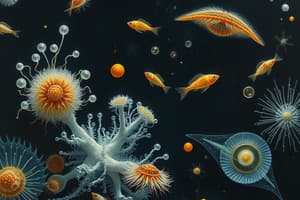Podcast
Questions and Answers
What is the primary food source for nearly all other marine life?
What is the primary food source for nearly all other marine life?
- Krill abundant in Antarctica
- Floating zooplankton with shells called tests
- Copepods, microscopic shrimp
- Phytoplankton and other photosynthesizing microbes (correct)
Which organisms have evolved specific functions to help with buoyancy and avoid sinking?
Which organisms have evolved specific functions to help with buoyancy and avoid sinking?
- Pelagic organisms (correct)
- Nektonic organisms
- Benthic organisms
- Cnidarians
What do some fish have that can be directly connected to the esophagus or filled with air only through blood vessels?
What do some fish have that can be directly connected to the esophagus or filled with air only through blood vessels?
- Gas containers
- Stinging tentacles
- Swim bladders (correct)
- Streamlined shapes and fins
Which organisms have streamlined shapes and fins to avoid sinking and provide lift?
Which organisms have streamlined shapes and fins to avoid sinking and provide lift?
What do floating zooplankton, such as radiolarians and foraminifera, have that sink to the ocean floor when they die?
What do floating zooplankton, such as radiolarians and foraminifera, have that sink to the ocean floor when they die?
What is the Crustacea subphylum that makes up most of the ocean's zooplankton biomass?
What is the Crustacea subphylum that makes up most of the ocean's zooplankton biomass?
What are examples of animals using gas containers for buoyancy?
What are examples of animals using gas containers for buoyancy?
Which organisms produce fats or oils with low density to float with minimal energy expenditure?
Which organisms produce fats or oils with low density to float with minimal energy expenditure?
What is a critical part of the food web in Antarctica, supplying food for various organisms?
What is a critical part of the food web in Antarctica, supplying food for various organisms?
Which organisms fall into two basic groups: hydras and jellies, and have stinging tentacles?
Which organisms fall into two basic groups: hydras and jellies, and have stinging tentacles?
What are examples of nekton organisms mentioned in the text?
What are examples of nekton organisms mentioned in the text?
What is the primary role of fins in marine organism swimming?
What is the primary role of fins in marine organism swimming?
What is the relationship between swimming speed and size in fish?
What is the relationship between swimming speed and size in fish?
How have deepwater nekton, like angler fish, adapted to perpetual darkness?
How have deepwater nekton, like angler fish, adapted to perpetual darkness?
What is the primary purpose of safety in numbers for smaller fish?
What is the primary purpose of safety in numbers for smaller fish?
What types of symbiotic relationships are mentioned in marine organisms?
What types of symbiotic relationships are mentioned in marine organisms?
What are some similarities between marine mammals and humans?
What are some similarities between marine mammals and humans?
What is the believed origin of the evolution of marine mammals?
What is the believed origin of the evolution of marine mammals?
What is highlighted about the transition of mammals into the ocean?
What is highlighted about the transition of mammals into the ocean?
What is the classification of marine mammals within the mammal group?
What is the classification of marine mammals within the mammal group?
Flashcards are hidden until you start studying
Study Notes
Marine Organism Adaptations and Behaviors
-
Nekton organisms include fish, squid, sea turtles, and marine mammals, which have various forms of swimming.
-
Organisms move through the water by contracting and expanding their fins, which play different roles such as stabilization, steering, balance, and thrust.
-
Different swimming motions include the "S" motion, which allows seahorses to stay afloat, and the caudal fin propulsion, utilized by predators like sharks.
-
Swimming speed is generally proportional to size, and most fish are cold-blooded, while predators are warm-blooded and have a higher metabolic rate.
-
Deepwater nekton, like angler fish, have adapted to perpetual darkness with bioluminescence and large, sensitive eyes.
-
Safety in numbers is a strategy used by smaller fish to avoid predation, as schooling helps confuse and scare predators away.
-
Symbiotic relationships in marine organisms include commensalism, mutualism, and parasitism, with examples such as Remora fish benefiting from sharks and clownfish benefiting from anemones.
-
Marine mammals, such as whales and dolphins, are warm-blooded and have adapted to life in the ocean.
-
Marine mammals, like whales, have adapted to deep diving, feeding on small morsels of detritus, and using bioluminescence to attract prey.
-
Marine mammals have large, sensitive eyes, expandable jaws, and a giant belly to accommodate scarce food in deep waters.
-
Marine mammals use the strategy of safety in numbers to avoid predation, often forming schools to confuse and scare away predators.
-
Symbiotic relationships in marine mammals include mutualism, such as the relationship between cleaner fish and larger marine animals, providing benefits to both parties.Evolution of Marine Mammals
-
Marine mammals share several similarities with humans, including being warm-blooded, breathing air, having hair or fur, and bearing live young with mammary glands for milk.
-
Mammals are closely related to marine organisms, highlighting the evolution of mammals into the ocean environment.
-
The evolution of marine mammals is believed to have started with species related to elephants or hippopotamuses that gradually adapted to shallow waters and eventually evolved into streamlined bodies to venture into the ocean.
-
These early species then evolved into the diverse range of marine mammals seen today, such as whales.
-
The transition of mammals into the ocean and their subsequent evolution into marine mammals is a remarkable process to consider.
-
The speaker mentions the major groups of marine mammals and their classification as a class within the mammal group.
Studying That Suits You
Use AI to generate personalized quizzes and flashcards to suit your learning preferences.




